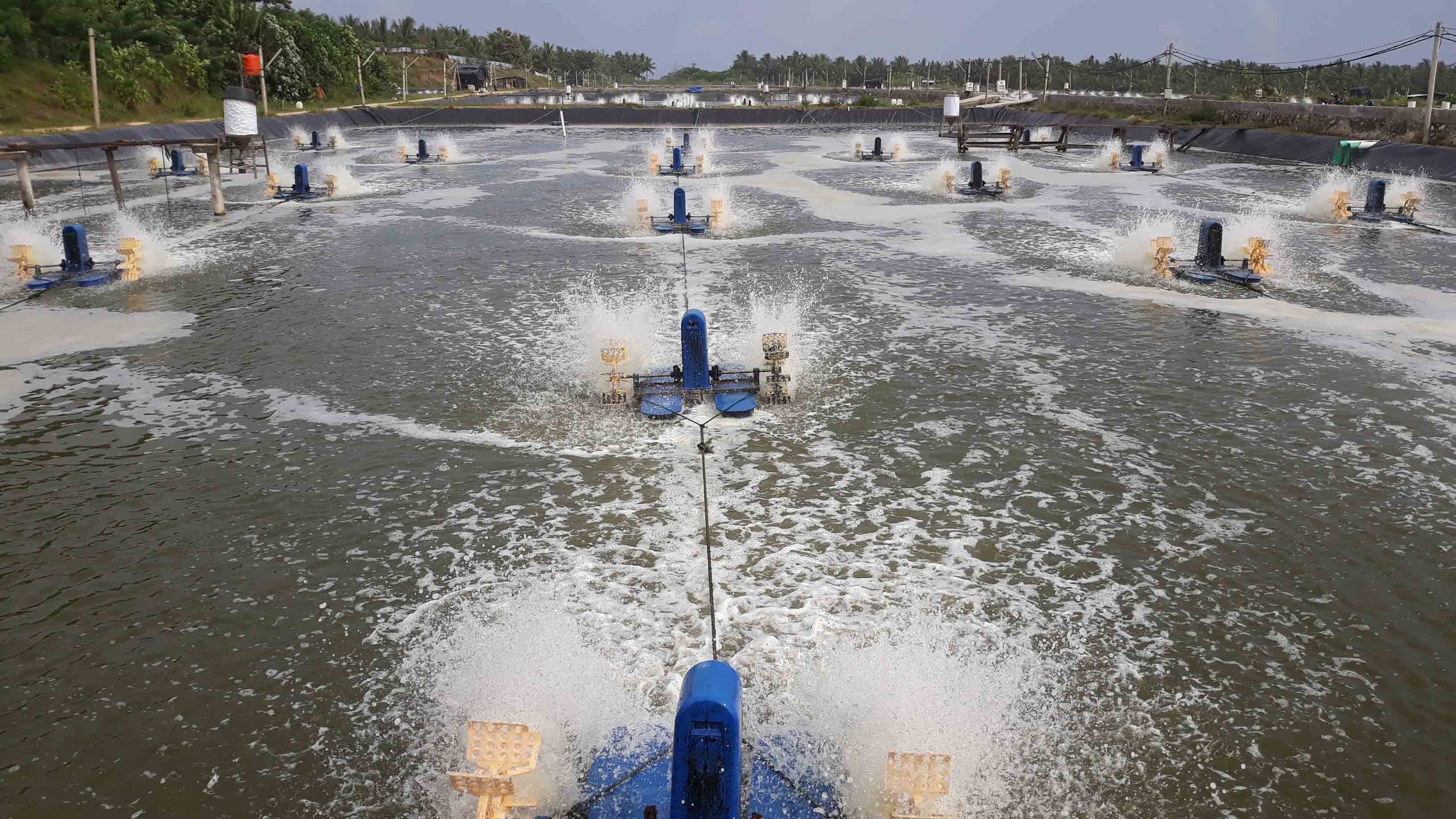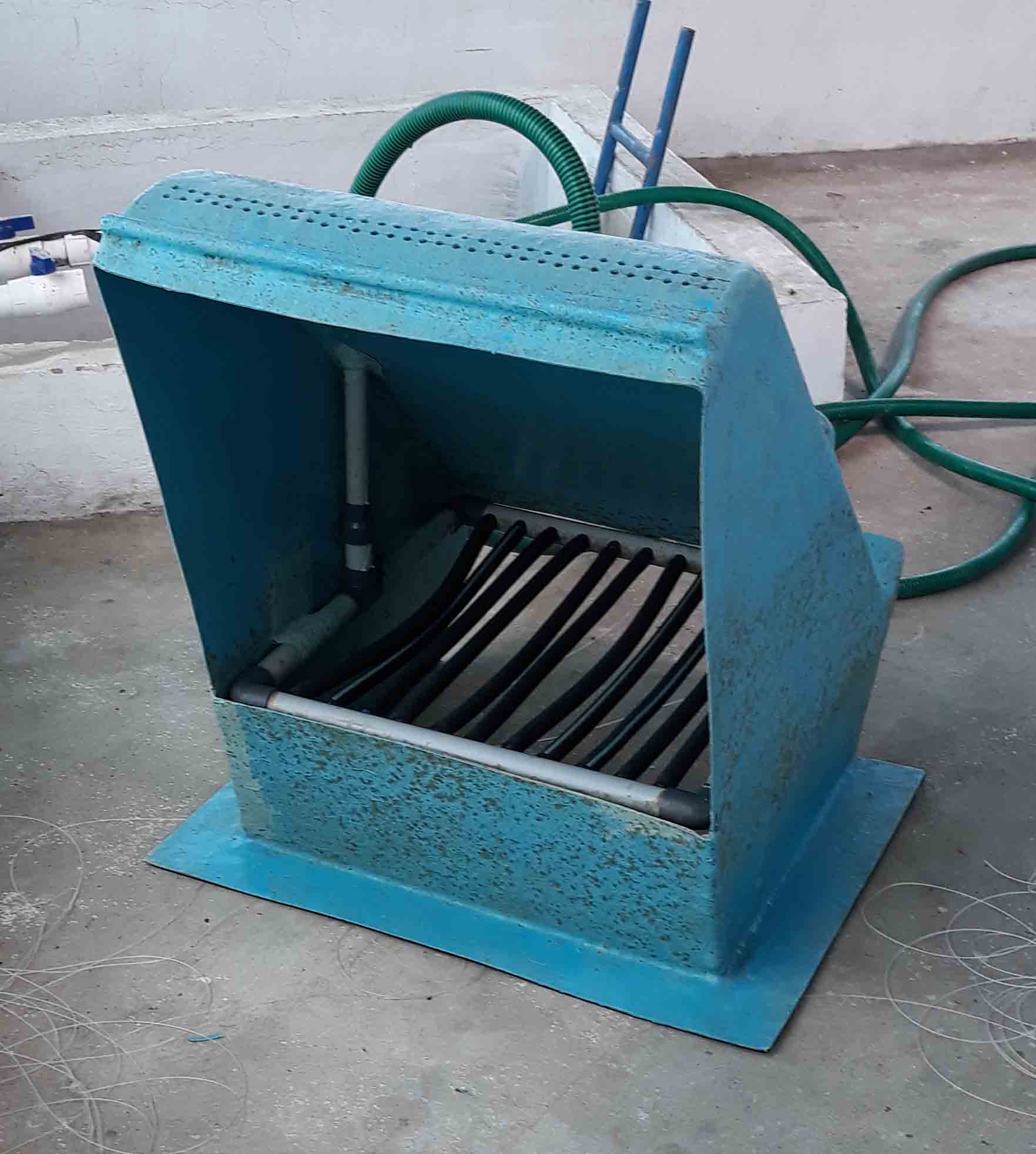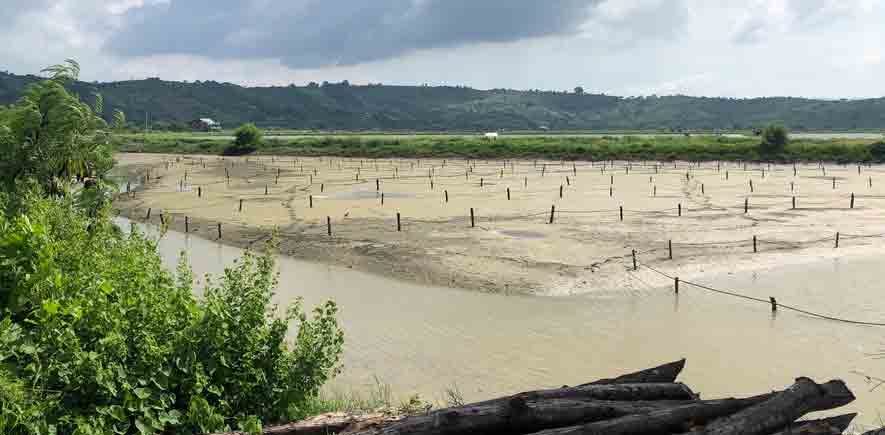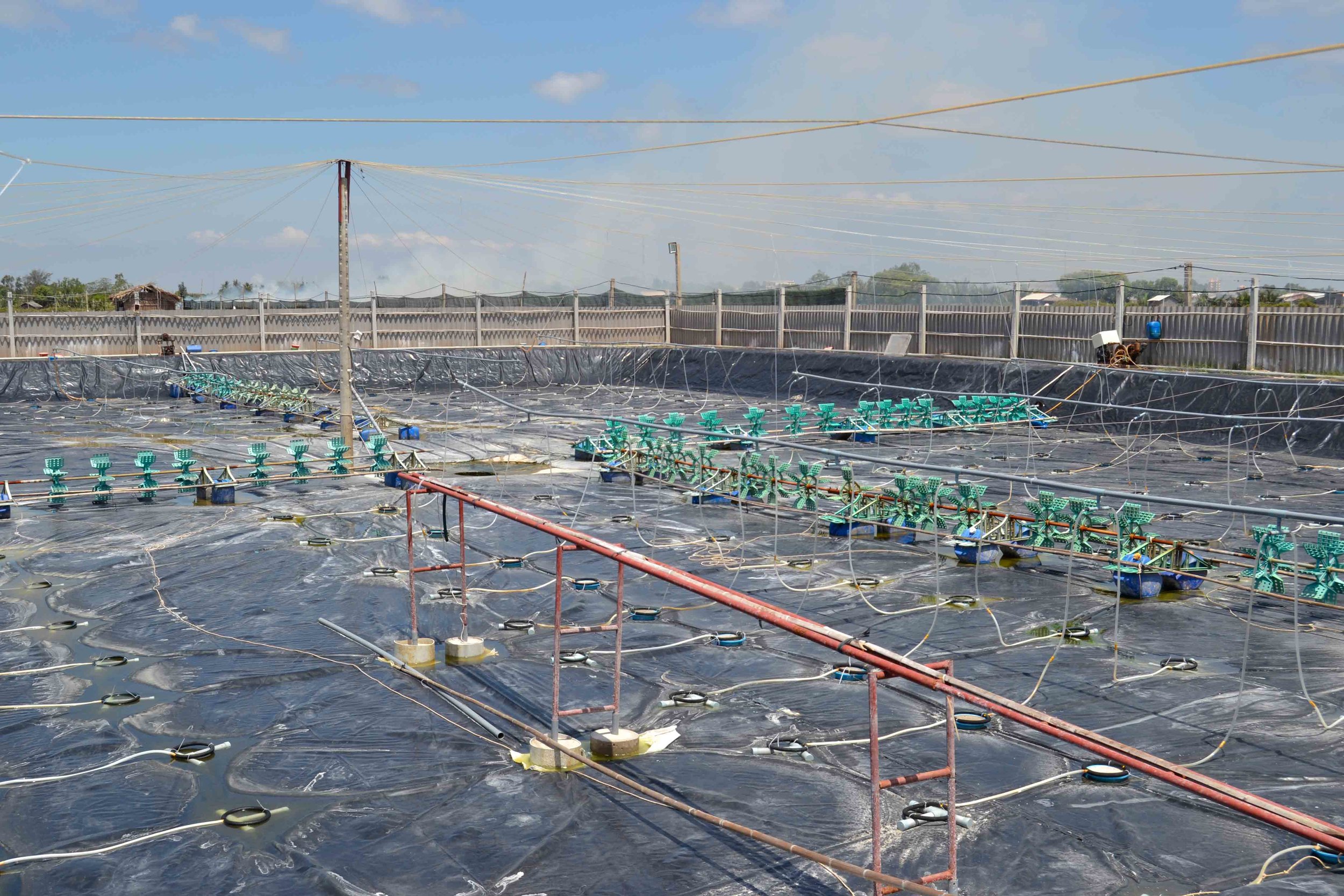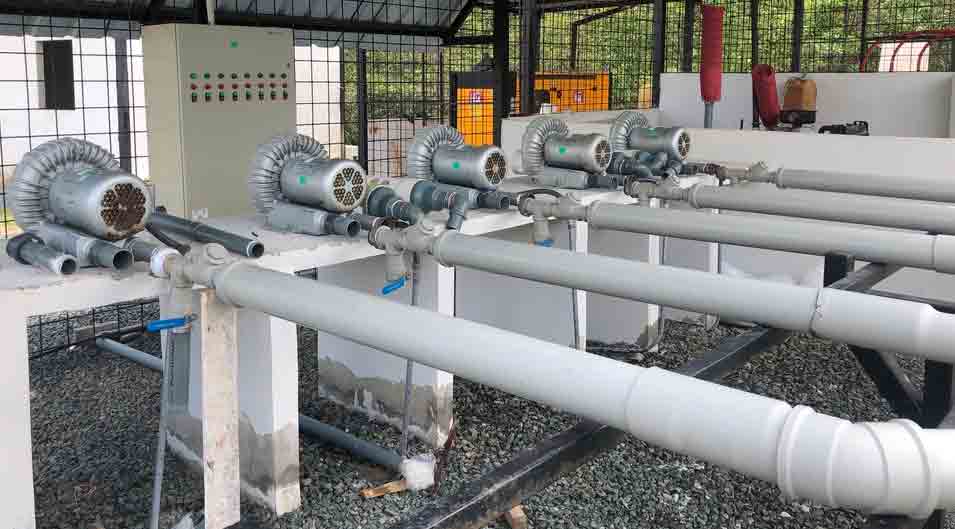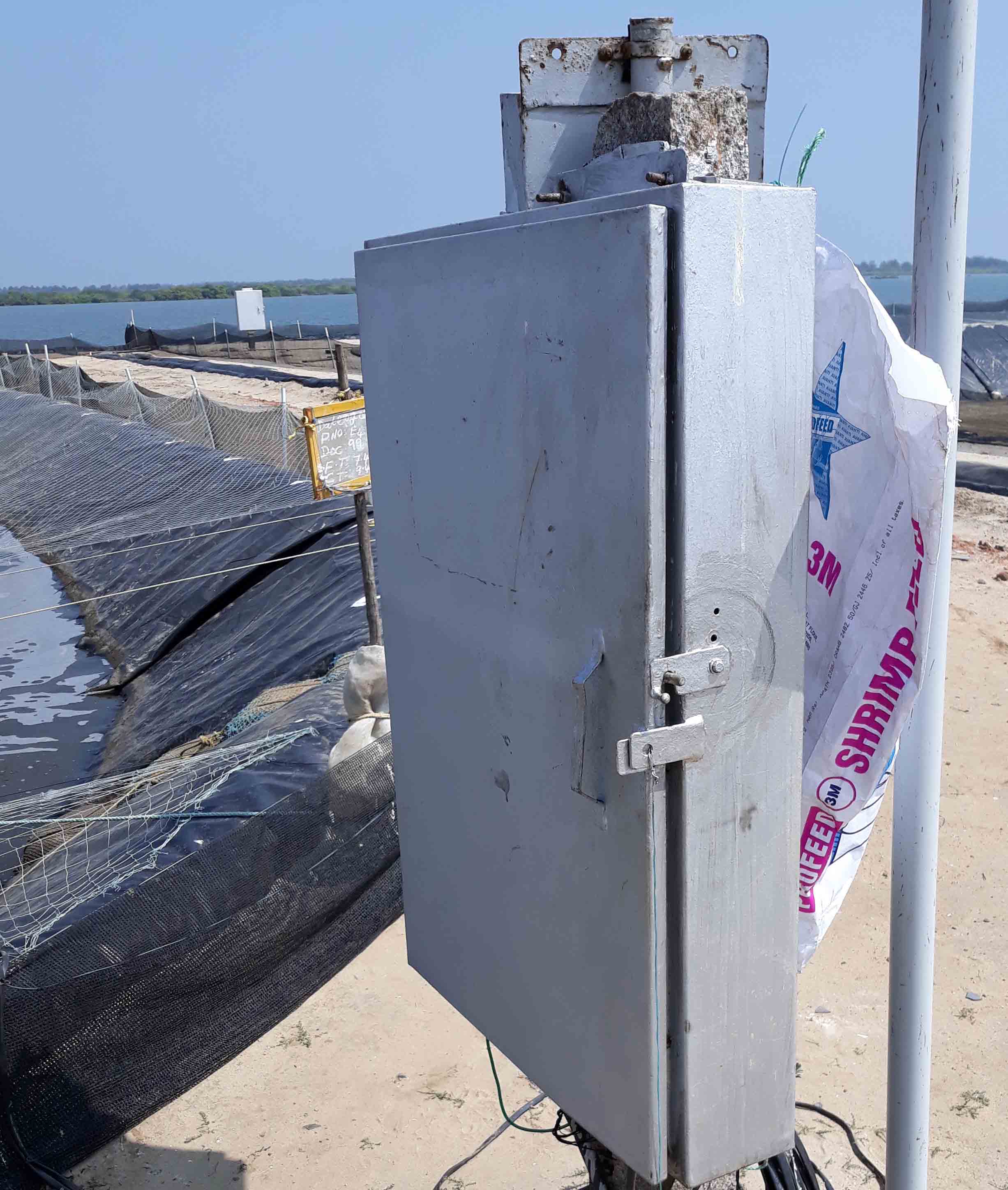Aeration
To increase the carrying capacity of water to host shrimp in enclosed systems, farmers need to increase the dissolved oxygen (DO) concentration in the water to sustain the physiological processes of shrimp. Naturally, the demand for oxygen is dependent on shrimp respiration requirements and biological oxygen demand (BOD). Farmers use DO levels in the pond as an indicator on whether or not to increase or decrease aeration. In response, when necessary, farmers add, allocate, and turn on aeration equipment in their ponds to keep the DO above the optimal level of 5mg/l.
There are various methods adopted by farmers to do this. We separated these methods into two main categories: floating and submerged aeration. The majority of floating aerators are made of multiple plastic paddlewheels mounted on short and long rotating steel arm rods which are elevated above the water with the support of floats and move using powered motors. The paddlewheels are partially submerged and rotate to mix water with air to dissolve oxygen into the water. The power of motors and the number of paddlewheels mounted on each arm varies depending on the farmers requirements and product availability on the market.
Alternatively, fully submerged aerators mix air with water where air is sucked or pumped into the water. More commonly, air is pumped into water using blower pumps to diffuse air into the water via various devices such as porous air-stones, ceramic disks, or hoses. Air is also sucked or injected into the water by the use of a venturi motor system or circumferential turbine motor system. Air blower or injection motors and models come in various sizes according to the pond design and farmers requirements and product availability on the market.
The demand for mechanical aeration depends on shrimp biomass, shrimp behavior, and in-situ water physical and chemical conditions during the day and night time. Usually, depending on the density of shrimp, modern farmers operate all aerators at night during non-photosynthesizing periods and use 50 to 80% of their aerators during the day.
Below is a country comparison on the use of varying aeration methods, models and operational control.
Data overview
| www.shrimpfarm.tech by HATCH | Indonesia | India | Ecuador | Thailand | Vietnam | China |
|---|---|---|---|---|---|---|
| Floating Aerator Models Short arm, long arm or turbine wheels |
Short arm | Short arm | Uncommon or short arm or long arm | Long arm | Long arm | Short arm |
| Aerator Floats HDPE moulds or plastic-covered polystyrene blocks |
HDPE moulds | HDPE moulds | HDPE moulds | Plastic covered polystyrene blocks | HDPE moulds | HDPE moulds |
| Floating Aerator Motor Power Range Hp range |
1 | 2 | Undefined | 3 to 11 | 2 to 8 | 2 to 5 |
| Wheel Quantity Per floating unit |
2 to 4 | 2 to 4 | 6 to 12 | 12 to 35 | 7 to 25 | 2 to 4 |
| Quantity of floating aerator units Units per ha |
48 | 10 | Undefined | 8 | 31 | 27 |
| Submerged Aerator Usage Non, uncommon or common |
None | None | Uncommon | Common | Common | Common |
| Submerged Aerator Infusion Models Turbine, venturi, blower with diffusion disks, air-stones or porous hose |
N/A (only in nurseries) | N/A | Blower with porous hose | Blower with porous hose | Blower with porous hose | Blower with porous hose |
| Submerged aeration motor power HP range |
N/A | N/A | 5 to 7.5 | 1 to 7.5 | 1 to 20 | 10 to 70 |
| Aerator Motor Operational Control Manual control box or digital remote control |
Manual control box | Manual control box | Manual control box | Manual control box | Manual control box | Manual control box |
Summary
The preference for specific models of floating aerators was primarily dictated by social drivers, market availability, shrimp stocking density and cost efficiency. Although the latter is debatable. There is a very clear discrepancy between countries on the use of different models of floating aerators and where Indonesia, China, and India use short arm aerators with 2 to 4 wheels per arm while Thailand and Vietnam farmers use long arm aerators each with between 7 and 35 paddlewheels per arm. Ecuadorian farmers, where possible, use long arm aerators with a maximum of 12 wheels per arm.
Indonesian farmers now use refurbished auto transmission motors as a cheaper alternative to buying new gear boxes used to rotate twin short arm aerators. See the images below.
Interestingly, only Thai farmers use polystyrene blocks covered with plastic lining to float their long aerators while the majority of other farmers in the remaining countries used plastic moulded floats.
Though submerged aeration is less popular, Ecuadorian farmers prefer blowers to pump air through HDPE hoses assembled in a grid throughout large grow-out ponds. In Thailand and Vietnam, many farmers use submerged aeration in combination to their floating long arm aerators. They either distribute porous hoses evenly throughout smaller ponds or concentrate hoses near and around their auto-feeders. Venturi aeration is not popular in outdoor grow-out production ponds possibly due to the vulnerability of cooling water temperatures if the exterior air temperature is lower than the optimal water temperature in ponds. The turbine motors were only seen in treatment reservoirs as they do not create water currents necessary for intensive farmers. However, farmers using the turbine motors to aerate and mix water in treatment-reservoirs complained that the propellers would constantly break due to excessive biofouling.
All aeration motors were controlled manually with a switch near or next to grow-out ponds with the exception of a corporate farm in Ecuador that used integrated software to remotely control aerators.
Innovation opportunities
Along with water pumps, aerators are by far the highest energy consuming devices on shrimp farms. With electricity prices on the rise, farmers look to improve the cost and oxygen dissolving efficiency of aerators. We hope that farmers can be empowered with measurement devices to better monitor the aerator energy consumptions and their dissolved oxygen outputs. Such tools will allow farmers to optimise energy use along with oxygen requirements
Many farmers also complain about aerator motors and other moving components breaking due to challenging salt corrosive environments. It is very costly for farmers to continuously spend time and money repairing or replacing aerator parts and thus more durable motors are high in demand. In addition, if farmers could remotely measure the mechanical performance of aerator motors and properly predict appropriate maintenance schedule, farmers would then spend less money and time replacing potentially un-repairable motors.
Some new products on the market such as gearless motors with fewer moving parts offer farmers to perchance longer lasting equipment but farmers prefer to keep repairing and refurbishing old motors until either the neighbouring farmers recommend an alternative or are presented with a new and proven cost-effective solution.
With the demand for cost-effective and durable aeration systems, we see a huge potential for innovation to facilitate these farmers needs.








